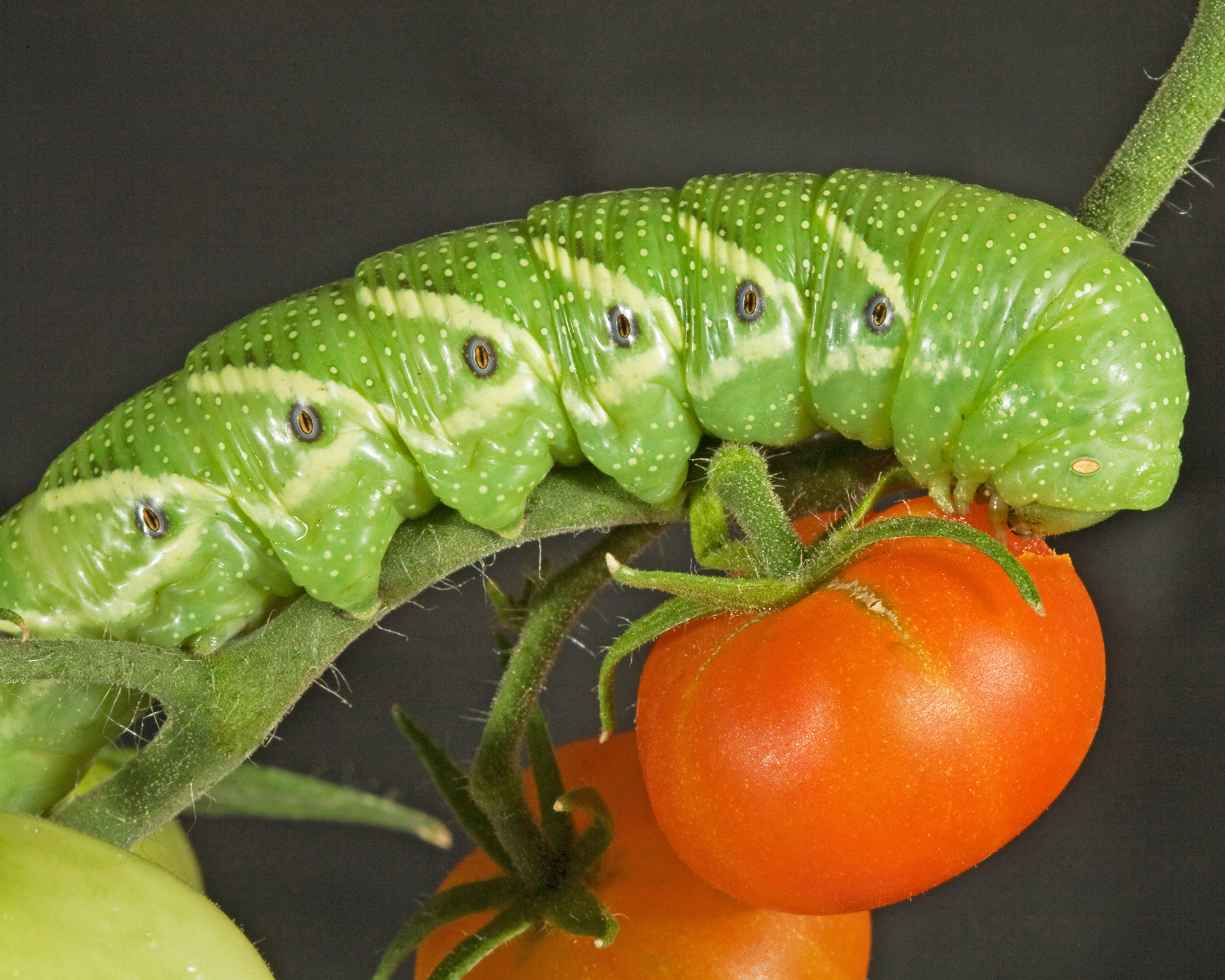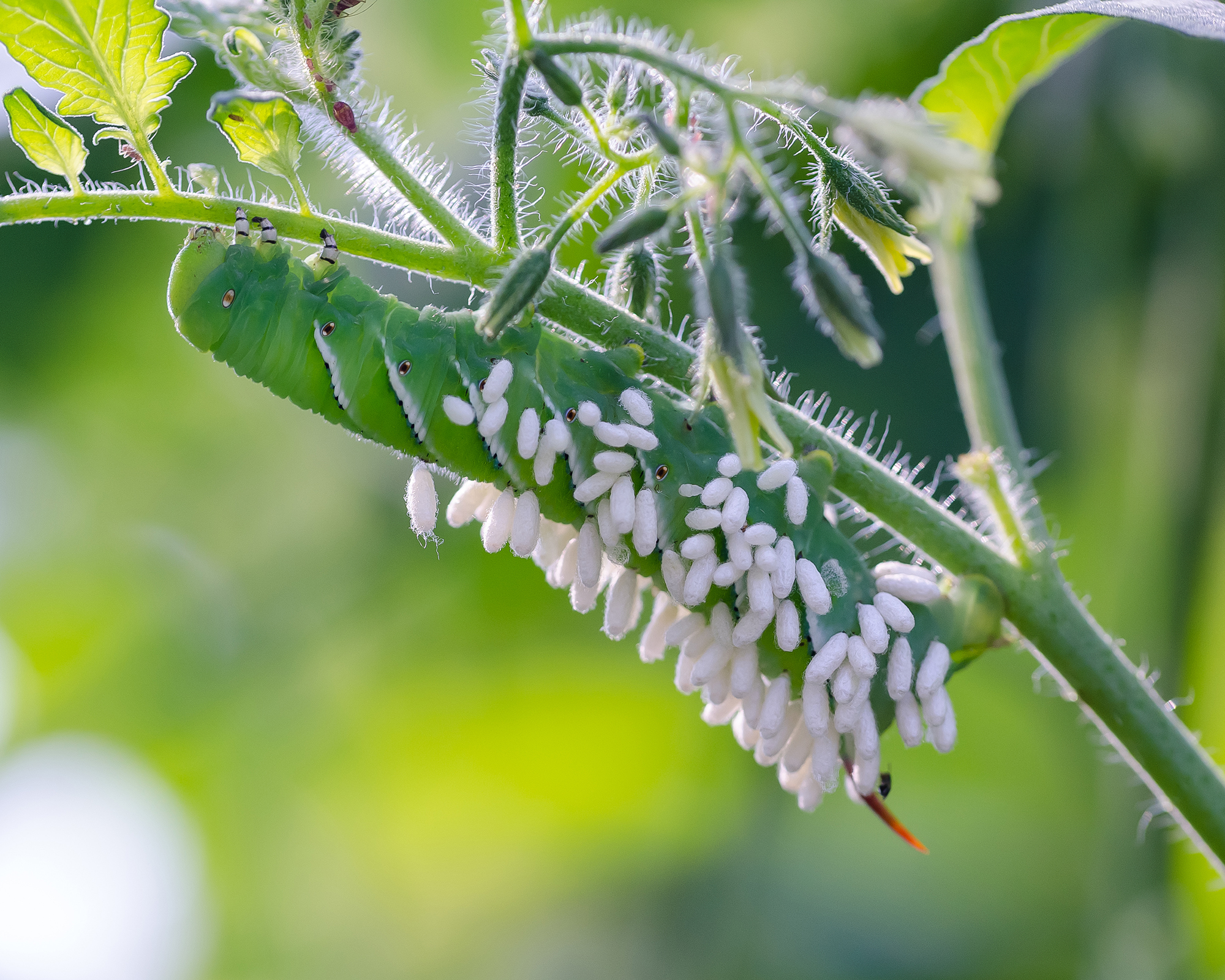How To Get Rid Of Tomato Hornworms: 5 Natural Solutions To Control And Repel Them
Are big green caterpillars feasting on your tomato plants? Discover natural methods to eliminate tomato hornworms – and keep your vegetable plot pest-free.

Heather Rhoades

Have you noticed big green caterpillars eating your tomato plants? Then your crops are likely being feasted on by tomato hornworms – or their closely related cousins, tobacco hornworms.
Common tomato pests, these greedy caterpillars can quickly strip the foliage of tomato plants as well as peppers, eggplants, and potatoes. You will need to act fast to get rid of hornworms, as they can get through a vegetable plot in record time.
Tomato hornworms are larvae of the five-spotted hawkmoth (Manduca quinquemaculata), and are more prevalent in northern states, while tobacco hornworms are larvae of the Carolina sphinx moth (Manduca sexta) and are more common in the South.
Managing these pests is key to growing perfect tomatoes by nurturing healthy, productive plants.
What Does A Tomato Hornworm Look Like?
Despite their large size – up to 4 inches in length – tomato hornworms tend to blend into foliage, so you may first see their destruction before you notice them.
Regularly check plants for stripped leaves, large holes, flower loss, and fruit damage. You may also spot the worms’ black droppings on leaves.
Tomato and tobacco hornworms look similar but with some differences:
Sign up for the Gardening Know How newsletter today and receive a free copy of our e-book "How to Grow Delicious Tomatoes".
- Tomato hornworms are bright green caterpillars with white striping forming a series of V’s. They have a dark green horn with black sides.
- Tobacco hornworms have a red horn and diagonal white stripes, rather than V’s.
- You may also spot other moth larvae visiting your crops, such as the darker offspring of the hummingbird moth. However, tomatoes are not usually their preferred meal.
Normally, when one tobacco or tomato hornworm caterpillar is found, others will be in the area as well.

Should I Kill Tomato Hornworms?
Hawkmoths and sphynx moths are striking insects, and are night-time pollinators. However, they are common and not at risk. Therefore, if tomato or tobacco hornworms are doing damage to your crops, then killing them is the best way to save the plants.
In the future, try to manage infestations by repelling the moths and their larvae from your plants, using the methods outlined below.
How To Get Rid Of Tomato Hornworms Naturally
Getting rid of tomato hornworms naturally is the best solution. Chemical insecticides can leach into plants and the soil, killing beneficial insects and upsetting the biodiversity of your garden. However, an early response is key, so keep a close eye on your crops.
Here, we reveal the best solutions for immediate treatment, as well as preventative measures to minimize the risk of hornworms returning.
1. Pick Them Off By Hand
It might sound unpleasant, but hand-picking tomato hornworms is the best way to control an active infestation. Hornworms do not bite and their large size makes them easy to handle. Wear gloves if you are squeamish!
Check over plants daily – the best time to do this is in the evening, when the caterpillars are most active. Shine a flashlight over the plants, to highlight the caterpillars, and carefully examine each leaf and stem, looking underneath leaves as well as on top.
When you spot a hornworm, pick it off the plant and drop it straight into a bucket of soapy water. Alternatively, if you have chickens, then save the hornworms to use as feed. They will love to feast on them.

2. Repel Them With A Homemade Spray
If you can’t manage – or bear – to handpick hornworms, then you could treat them with a homemade spray. This recipe uses cayenne pepper, which is detested by hornworms. It’s a deterrent rather than a cure, but can also kill them:
- In a bottle, add 1 cup of water, a teaspoon of dish soap, and ¼ teaspoon of cayenne pepper. Shake to mix.
- Spray over plants’ leaves, including the undersides. You will need to do this several times per week, especially after it rains.
- Instead of adding to the spray, you can lightly sprinkle cayenne pepper directly over affected areas.
3. Use Bacterial Insecticide
If you are struggling to manage tomato hornworms, then try using Bacillus thuringiensis (Bt), a natural pesticide allowed in organic farming.
Bt is a naturally occurring bacterium, common in some soils, that causes disease in certain insects – notably leaf and needle-feeding caterpillars. It contains a crystal protein, which paralyzes the hornworms’ digestive system. Over a period of a few days, they will stop feeding and starve to death.
Bacillus thuringiensis is harmless to humans and beneficial insects, although it will kill butterfly larvae, so only use it on affected crops where there is an active infestation.
Usually applied as a spray, It is most effective when the caterpillars are young and have not had a chance to cause severe damage. So check plants daily.

4. Attract Predatory Insects
Predatory insects are your best friends in the fight to control tomato hornworms, doing the dirty work for you. However, they are not an instant solution and should be encouraged as part of a long-term control plan.
Braconid wasps lay their eggs on tomato hornworms, and the larvae eat the caterpillar from the inside out. If you find a tomato hornworm caterpillar in your garden covered with white rice-like sacks, leave it alone as the wasps will mature and the hornworm will die. The mature wasps will then create more wasps and kill more hornworms.
Ladybugs and green lacewings will also feed on young caterpillars or eggs. Both can be purchased and added to gardens.
You can attract predatory insects to your yard by including favorite plants such as alyssum, dill, yarrow, white clover, and marigolds.
5. Deter Hornworms With Companion Plants
Tomato companion plants are invaluable in the control of tomato hornworms and other pests such as thrips and aphids. Their flowers or foliage produce a strong scent that repels bad bugs, yet are often a draw for beneficial and pollinating insects.
Borage, basil, marigolds, and nasturtiums are particularly effective – interplant them among your tomato crops.
As well as controlling pests, companion planting has other benefits, helping to boost nutrients and even improve flavor.

Melanie is an experienced gardener and has worked in homes and gardens media for over 20 years. She previously served as Editor on Period Living magazine, and worked for Homes & Gardens, Gardening Etc, Real Homes, and Homebuilding & Renovating. Melanie has spent the last few years transforming her own garden, which is constantly evolving as a work in progress. She is also a passionate organic home grower, having experimented with almost every type of vegetable at some point. In her home, Melanie tends to an extensive houseplant collection and is particularly fond of orchids.
- Heather RhoadesFounder of Gardening Know How